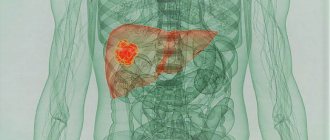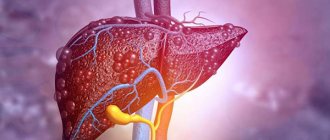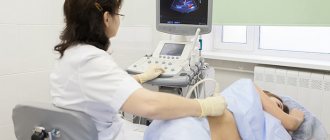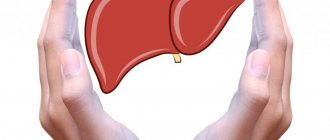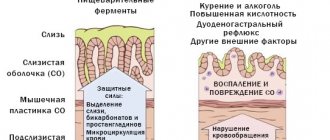The article was prepared by a specialist for informational purposes only. We urge you not to self-medicate. When the first symptoms appear, consult a doctor.
The human body is designed in such a way that all organs can be divided into vital and auxiliary. The liver definitely belongs to the first group. Its importance for maintaining the vitality of the body cannot be overestimated. After all, it is a powerful parenchymal organ that combines the functions of the digestive gland and a kind of biochemical laboratory.
It is here that all the central biochemical reactions and processes responsible for maintaining life occur. Naturally, the more complex the structure of an organ and the higher the load on it, the more vulnerable it is. And despite the excellent regenerative and restoration abilities of the liver, the number of liver diseases that develop into liver failure continues to grow steadily.
Where is the human liver located?
Like all vital organs, the liver is located in the central regions of the body. It occupies virtually the entire upper right section of the abdominal cavity, located under the diaphragm. The bulk of the organ is fixed by ligaments under its right dome, which is projected onto the anterior abdominal wall, as the area of the right costal arch and hypochondrium. From this section, the liver goes to the left, gradually narrowing until the edges are completely connected at an acute angle in the form of a wedge closer to the left hypochondrium. Therefore, if there are problems with the liver, patients complain of pain or discomfort in the right hypochondrium with possible spread to the epigastrium.
Functions of the liver in the human body
No other organ in the human body provides as many functions as the liver performs. These include:
- Detoxification of the body - neutralization of all toxic compounds that enter the blood from the environment (alcohol, toxins, medications);
- Recycling and inactivation of toxic metabolic products formed in the body during vital activity (protein breakdown products, phenol, ketone compounds and acetone);
- Participation in vitamin and mineral metabolism: deposition of water-soluble vitamins B, C, PP, as well as fat-soluble D, E, K, microelements iron, copper and cobalt;
- Participation in the synthesis of steroid sex, thyroid, adrenal hormones and neutralization of their excess;
- Regulation of carbohydrate metabolism;
- Deposition and distribution of energy substrates in the body (glucose, glycogen) through the processes of glycogenolysis, gluconeogenesis, glycolysis;
- Participation in lipid metabolism (metabolism of cholesterol, phospholipids, fatty acids, lipoproteins);
- Implementation of central processes of protein metabolism: synthesis of protein components for cell membranes and transport proteins, redistribution of amino acids;
- Participation in the synthesis of immunogobullins, antibodies and other important proteins of the immune system;
- Synthesis of plasma coagulation factors and blood anticoagulation system;
- Function of hematopoiesis, especially in the prenatal and childhood periods;
- Synthesis of bile and enzymes that are involved in digestion processes. Their main role is the breakdown of fats;
- Carrying out bilirubin metabolism and its neutralization by conjugation with glucuronic acid;
- Depositing blood, which allows it to be redistributed in case of need (release of blood into the vessels when there is a deficiency during blood loss or concentration during congestive heart failure);
The liver is the largest gland of the human body, which performs the most functions among all organs. Liver damage can be accompanied by a violation of one or all of its functions, which underlies the severity of the disease.
Liver diseases
The group of liver diseases can include any types of damage to all structures that do not go beyond the anatomical limits of this organ. These can be hepatocytes and the hepatic lobules that they form, intrahepatic arterial and venous vessels, and bile ducts. Diseases of the extrahepatic bile ducts and gallbladder should be considered under a separate heading.
The main common liver diseases are shown in the table:
| Liver disease group | Nosological units from the group |
| Primary inflammatory, purulent and functional damage to liver cells |
|
| Traumatic injuries |
|
| Vascular diseases |
|
| Damage to the intrahepatic bile ducts |
|
| Tumor diseases |
|
| Parasitic infestations and infections |
|
| Hereditary pathology and anomalies |
|
| Liver damage due to pathology of other organs |
|
| Structural and functional changes in the liver and their complications |
|
| Autoimmune liver diseases | Pathology in which causeless destruction of the liver by its own immune system occurs:
|
Any liver disease that progresses ends in cirrhosis and is accompanied by varying degrees of hepatobiliary insufficiency.
Treatment technologies
After processing all the data, three options are possible: the doctor will prescribe a special diet for you; will prescribe complex drug treatment to eliminate the causative agent of the disease; or will also prescribe additional treatment, taking into account the existence of other pathologies (diseases of the cardiovascular system, respiratory, urinary, etc.)
Acute diseases of the liver and gallbladder are completely curable in most cases, but chronic diseases are almost impossible to completely cure. During chronic treatment in our clinic, doctors achieve rapid relief of exacerbation, long-term remission, preservation of maximum liver function (that is, compensation for liver failure), and the gall bladder.
Timely diagnosis and prompt initiation of treatment will reduce medical intervention, as well as the consequences of the disease, to a minimum. Contacting a gastroenterologist at our clinic guarantees you qualified diagnostic and therapeutic services. You will be treated according to an individual program.
Signs and symptoms of liver disease
Symptoms of liver disease include frequent nausea, heartburn, a very unpleasant, pungent odor of sweat, yellowish skin color, dark yellow urine, diarrhea, discoloration of feces to dark brown or light yellow, sometimes green.
Also, liver disorders can lead to acne in adulthood, frequent feelings of hunger or strong and frequent thirst, itching of some thin areas of the skin, and blurred vision. For example, a person may begin to confuse white with yellow, suddenly feel either cold or hot, and cannot sleep at night, experiencing fever and rapid heartbeat. Hair and eyebrows may begin to fall out. Convulsions occur, papillomas form, and the development of atherosclerosis of the brain, heart, intestines, and blood vessels of the legs begins.
Typical cases of organic and functional liver problems are easily recognized by their characteristic symptoms. But some situations make it difficult for even experienced hepatologists (specialists who deal with liver diseases) to make a correct diagnosis. It all depends on the specific type of disease, the individual characteristics of the body, the presence or absence of concomitant pathology.
The main clinical manifestations of liver pathology may be:
- Discomfort and pain in the projection of the liver;
- Enlargement of the liver;
- General weakness and malaise;
- Headache;
- Impaired mental and thinking abilities;
- Increased skin sweating and swelling;
- Yellowness of the skin and sclera;
- Skin rash;
- Severe itching of the skin;
- Increased fragility of blood vessels and tendency to bleeding;
- Signs of hypovitaminosis;
- Stool instability, changes in the nature and color of stool;
- Increase in abdominal size;
- Increased venous pattern on the skin of the abdomen;
- Unmotivated weight loss;
- Bitterness in the mouth;
- Cracks on the surface of the tongue and its coating with a white or brown coating;
- Temperature reaction of varying severity.
How does your liver hurt?
Pain due to liver damage can be of a different nature. They can be interpreted like this:
- Minor pain in the right hypochondrium in the form of aching pain, bloating and heaviness. Characterize a sluggish pathological process of inflammatory toxic or other origin. This type of pain in the liver is most likely caused by an increase in the size of the organ and overstretching of the liver capsule. Patients cannot clearly identify one pain point;
- Intense widespread pain in the right hypochondrium. They are rare and speak of either a pronounced inflammatory, purulent, traumatic pathological process, or damage to the bile ducts by stones;
- Severe local point pain in the projection of the liver. It is not typical for liver damage and in most cases is associated with pathology of the gallbladder and extrahepatic bile ducts;
- Complete absence of pain in the liver. It is very common in indolent liver diseases, which remain undetected for a long time and are detected only at the stage of liver failure or cirrhosis.
Skin with liver diseases
Based on the characteristics of the skin, one can determine the functioning of various organs, including the liver.
With such diseases, the skin may be:
- Pale or dark-skinned with severe sweating and swelling of the subcutaneous tissue, especially in the face and limbs;
- Dry, flaky with multiple scratch marks and cracks;
- Prone to allergic rashes, atopic dermatitis, psoriasis, eczema;
- Jaundice. By the nature of this type of skin changes, one can determine the origin of jaundice. In case of liver problems, jaundice is of moderate intensity and is represented by an orange tint. When carrying out the differential diagnosis of jaundice, this criterion allows us to exclude mechanical types (brown skin tone) and hemolytic types, accompanied by a lemon-yellow skin tone;
- With the presence of striae. Striae are stretch marks of the skin, mostly of the abdomen, in the form of bluish stripes of thinning. The reason for their appearance is a hormonal imbalance, both in the male and female body, when the liver is not able to neutralize excess steroid hormones.
Rash due to liver disease
In most patients with liver pathology, along with changes in skin color, various rashes appear.
The mechanisms of occurrence and types of rash can be as follows:
- Pustular elements, tendency to folliculitis and furunculosis. They are based on an immune imbalance that occurs against the background of a decrease in the liver’s ability to synthesize immunoglobulins;
- Allergic rash of the type of spots and papules. It is caused by a violation of the detoxification function of the liver, which underlies the occurrence of allergic reactions to environmental conditions familiar to the body;
- Hemorrhagic rash. Small hemorrhages over the entire surface of the skin, which are called petechial rashes, are typical manifestations of a decrease in the synthetic function of the liver. First of all, the proteins that make up the blood coagulation system are affected. Such patients have an increased tendency to form hematomas at the slightest injury.
Itching in liver diseases
It is characteristic that any type of skin rash in liver diseases is accompanied by severe itching. It becomes especially persistent when yellowing of the skin is combined with rashes. This symptom is explained by the fact that bilirubin, which is not neutralized by the liver, is deposited in the skin, causing irritation. In addition, other toxic metabolic products are concentrated in the wide microcirculatory network of the skin, which additionally causes irritation and itching. In this regard, when examining patients with liver pathology, you can notice scratch marks, especially on the lateral surfaces of the abdomen and forearms.
Causes of liver diseases
Liver tissue simply has tremendous potential in terms of its ability to recover and resistance to harmful environmental factors.
Possible causes of liver problems include:
- Viral agents.
These include hepatitis viruses types A, B, C, D, E and other rare types. They lead to the occurrence of acute and chronic inflammatory processes in the liver tissue, which are called hepatitis, according to the name of the virus. Hepatitis A is considered the most favorable type of viral hepatitis, hepatitis B is considered dangerous, and hepatitis C becomes chronic and is detected at the stage of cirrhosis;
- Toxic influences.
Long-term and systematic intake of toxic compounds from the environment (vapors, chemical compounds, heavy metals) into the body or immediate exposure to high doses of them on the liver leads to damage to this organ. In this case, both moderate enlargement of the liver without pronounced functional disorders and massive necrosis of hepatocytes with the transition to progressive hepatocellular failure may occur;
- Medicinal influences.
Not all drugs have the same hepatotoxicity. The most aggressive of them are chemotherapeutic agents, antibiotics, and hormones;
- Alcoholic drinks.
Systematic abuse of ethanol-containing products causes a direct detrimental effect on liver cells. Over time, this leads to cirrhosis of the liver. The established safe daily dose of 40% ethanol for the liver does not exceed 90-100 milliliters for men, and 50-70 ml for women;
- Infectious and parasitic agents.
Among them, the main place is occupied by echinococcus and alveococcus, roundworms, and the causative agents of leptospirosis. They cause both acute pathological changes and cause chronic processes in the form of cystic transformation of the liver;
- Errors in diet and improper nutrition.
In this regard, the most dangerous is the systematic abuse of fatty, fried, smoked and foods containing a large amount of spices. This causes a violation of the outflow of bile, which leads to its stagnation, cholangitis and the formation of stones in the ductal system of the liver;
- Hereditary predisposition
, genetic diseases and developmental defects. This type of cause underlies various atresias of hepatic vessels and ducts, liver hypoplasia, storage diseases and enzymopathies;
- Acute diseases of the abdominal organs
accompanied by suppurative processes. They can lead to the spread of suppuration into the portal vein system, which will cause thrombosis;
- Abdominal and liver injuries
. They matter not only in the immediate future after their occurrence. Sometimes, several years after injury, cysts or other fluid accumulations in the liver parenchyma may be detected;
- Ionizing radiation
and other physical and chemical carcinogens. These causative factors can cause cancerous degeneration of certain areas of the liver tissue.
The liver has one of the highest regenerative abilities of all body tissues. The degree to which the harmful influence of causative factors in the development of liver diseases is realized largely depends on lifestyle
On this topic:
List of the best hepatoprotectors for liver restoration
Diet for liver diseases
Compliance with a dietary regimen for liver diseases is a mandatory attribute of the treatment process. Sometimes his performance depends on this. Every patient with liver pathology should remember this. It is very important to adhere to clear lifestyle recommendations to maintain the liver in a state of relative functional rest.
What should you exclude from your diet?
The following foods should be excluded from the diet:
- Alcohol is strictly prohibited, even in small quantities.
- Coffee and strong tea;
- Grape juice, tomatoes and tomato juice
- Mineral sparkling water, especially with dyes, or regular, very chilled water
- Fatty meats (pork, duck, goose) and offal (kidneys, liver, brains, heart);
- Broths made from rich meat, fatty ones, mushroom broths, based on legumes and sorrel are not allowed.
- Pearl barley, corn, barley and millet porridge
- Pasta with additives, pastas and sauces with fat, strong tomato dressings and creamy sauces
- All types of smoked products, sausages, canned food, excluding confectionery fat, lamb, beef and pork
- Fatty fish (salmon, salmon, sturgeon, eel, carp, stellate sturgeon, catfish), including salted and smoked fish.
- Any type of caviar and sushi
- Fresh bread and pastry products (buns, pies, donuts, cookies);
- Ryazhenka, full-fat milk and cottage cheese, salted and seasoned cheeses
- Some vegetables: cabbage, Brussels sprouts, sorrel, spinach, pickles, pickles, garlic, onions, eggplant, mushrooms, radishes, turnips, asparagus and cooked bell peppers
- Almost all types of fresh fruits and berries including dates, cranberries, grapes, figs and raspberries
- If you have liver pathology, you should not eat a lot of eggs, as well as fried eggs.
- For snacks, sushi, smoked meats, spicy and fatty dishes are not allowed;
- For sweets, all products containing chocolate and cocoa, cream, or a lot of confectionery fat are prohibited
- Any seasonings, mustard, vinegar, pepper, adjika, ketchup, mayonnaise, and sauces, especially hot ones;
What foods are allowed for liver diseases
The following products are allowed for liver diseases:
- Beverages. A decoction of rose hips, weak black tea with lemon and milk. Instead of sugar, you can use substitutes (xylitol). Juices from berries and fruits without sugar. Compotes are prepared from dry and fresh fruits, grinding them.
- Rye or bran bread, or day-old wheat bread (or stale), sponge cake, biscuit-type cookies;
- Lean meat products. Recommended meat: turkey, beef, rabbit, chicken. It is better to remove the skin from poultry meat;
- Low-fat fish varieties. Attention is focused on pike perch, pike, cod, and all low-fat varieties of river fish;
- Oils. Refined vegetable oils (up to 10 g) and butter (up to 10-30 g) are allowed;
- Low-fat dairy products. It can be yogurt, low-fat or low-fat cottage cheese, non-sharp varieties of cheese. Kefir and milk can only be low-fat, the maximum amount of fat should not exceed 2%. You can diversify the menu with cheesecakes, lazy dumplings, puddings.;
- Eggs. The recommended number of eggs per day is only one. These can be eggs of any type of bird;
- It is better to prepare vegetable dishes from potatoes, pumpkin, cauliflower, zucchini, carrots and beets. Green peas and Chinese cabbage will perfectly complement the menu. Vegetables can be boiled, mashed and made into puree soup, soufflé, and casseroles with meat and fish. Salads with a neutral taste (corn, iceberg, romaine) are welcome in small quantities. Bell pepper is useful;
- You can use any kind of noodles and pasta, buckwheat, rice, oatmeal - all boiled;
- You can season ready-made dishes with bay leaf, cinnamon, parsley, dill, and vanilla. Great for adding flavor to soy sauce.;
- For people with liver pathology, confectionery and sweets should be represented by fruit jam, small quantities of honey, and marmalade.
- Snacks. The diet for liver disease does not limit the consumption of fresh vegetable and fruit salads seasoned with refined oil; After boiling, the fish is made into aspic, low-fat varieties of herring are soaked, and stuffed fish is made. Sauerkraut without vinegar is allowed in small quantities so as not to cause flatulence. From the usual salads: vinaigrette, zucchini in the form of caviar.
In what form should the food be prepared and consumed?
Any food should be steamed, stewed, baked, boiled. Under no circumstances should they be fried or smoked. It can be soup, puree soup, casserole, pudding, puree, or simply boiled products in their pure form. You can combine permitted foods in salads and stews. Be sure to season them properly. This will provide the body with sodium and chloride ions. Ready meals must be warm before consumption. It is better to adhere to the principle of fractional dosed 6 meals a day. This approach will create the most gentle relationship with the liver and provide the body with nutrients.
On this topic:
Complete list of permitted and prohibited foods for the liver
The role of drugs in human life
Modern medicines are a great achievement of scientific and technological progress. Thanks to the success of drug therapy in combination with other methods and means of treatment and prevention, mortality from infectious diseases (scarlet fever, diphtheria, tuberculosis, pneumonia, etc.), including especially dangerous ones (plague, cholera, smallpox), has significantly decreased. Practical medicine has highly effective drugs for diseases that were previously incurable or almost incurable (tuberculous meningitis, blood poisoning, cancer, etc.).
But at the same time, we must not forget about the other side of the coin - the complications and undesirable side effects of drugs, the frequency of which has been increasing over the past decades. This is a consequence of the imperfection of our knowledge of the intimate processes of the human body and medications, especially if there are several of them, insufficient knowledge of the properties and mechanisms of action of individual medications and their interaction in the body. Patients' access to medicines is of great importance; many medicines are dispensed without prescriptions; methods, doses and regimens for taking the drug are not followed; self-medication and trust in drug advertising are widespread among the population.
Prevention of liver diseases
Unfortunately, the prevention of liver diseases depends not only on the correct behavior of one person, who, even with all his desire, will not always be able to protect himself from them. Liver pathology is to some extent a social problem. Among the reasons for its development, there are those that are extremely difficult to influence by ordinary adherence to preventive recommendations. But everyone must strive for this: state government structures, medical institutions, public catering facilities and every person who monitors their health.
The following measures can be taken to prevent liver diseases:
- Compliance with hazardous production technology with the exception of waste disposal into wastewater or air;
- Compliance by workers in hazardous production with rules for working with toxic substances, use of personal protective equipment;
- Purchasing only fresh food from trusted suppliers. Many of them are grown and transported using chemical processing, which is extremely harmful to the liver;
- Elimination of alcohol abuse;
- Carry out strict control over the processing of instruments in surgical clinics and dental offices. Use disposable devices as much as possible in practice;
- Strict control over the condition of donor blood and its preparations, as well as donors. This will prevent cases of viral hepatitis;
- Isolate patients with viral hepatitis A;
- Avoid unprotected, irregular sexual relations;
- Compliance with the principles of healthy eating;
- Vaccine against hepatitis B for persons at risk of developing this disease;
- Monitor the condition of patients with chronic liver diseases;
- Avoid uncontrolled use of medications;
- Use hepatoprotectors if there is a threat of liver damage;
- Seek medical help promptly if there is any suspicion of liver disease;
- Proper treatment of any pathology that a person has that can lead to secondary liver damage.
Liver diseases are a serious threat to health and life, which in no case should be left without proper attention!
Tips for liver disease
Those who suffer from liver disease need to give up bad habits, eating spicy, hot, fatty foods. Heat and tanning should be avoided. Food should be consumed steamed, boiled, or stewed. It is not recommended to eat yesterday's food. You should not eat onions and garlic, but it is better to add horseradish and mustard to your food; eat boiled chicken, not fried chicken. You also can’t eat duck, goat meat, or dried meat. Eat vegetables raw. Do not eat too much dairy products, eat often, but little by little.
You can eat sweets; sweet tea can help with liver pain. Also eat foods that are sweet, bitter, or astringent.
The meaning of the gland
The liver is responsible for purifying the blood, most of the blood flow is sent to the arteries and veins of the digestive organs, the rest serves as the basis for the supply of oxygen. The functions of the organ are filtration, restoration of standard indicators of protein and carbohydrates.
The gland answers:
- for the production of plasma proteins;
- cleansing the bloodstream of toxins;
- metabolism of ammonia to urea;
- thermoregulation;
- production of bile secretion;
- synthesis of digestive hormones, enzymes;
- normalization of lipid and carbohydrate metabolism, production of nutrients, etc.
The organ allows you to neutralize and remove harmful or excess exogenous and endogenous substances from the body.
